14 nov 2016
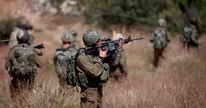
Several Palestinians were injured as clashes erupted Monday afternoon in Tamun town east of Tubas to the north of occupied West Bank.
The clashes broke out when Israeli forces stormed the town to conduct military drills in the area, local sources told the PIC reporter in the city.
Local youths and secondary students had stoned during the clashes Israeli forces after they erected a military checkpoint in the area.
Israeli forces responded by firing heavy teargas bombs at the students.
Several injuries were reported among the students during the clashes.
The clashes broke out when Israeli forces stormed the town to conduct military drills in the area, local sources told the PIC reporter in the city.
Local youths and secondary students had stoned during the clashes Israeli forces after they erected a military checkpoint in the area.
Israeli forces responded by firing heavy teargas bombs at the students.
Several injuries were reported among the students during the clashes.
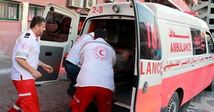
At least five Palestinians suffered teargas bombs after Israeli Occupation Forces (IOF) suppressed a peaceful march in Auja town in Jordan Valley.
The Palestinian Red Crescent affirmed that five Palestinians were injured during the event, one of them was taken to an Israeli hospital in very critical conditions.
Local sources told PIC reporter that the protest march was organized after Israeli forces demolished a home in the area.
However, Israeli forces heavily fired teargas bombs and pepper gas towards the protesters which led to the outbreak of violent clashes.
The Palestinian Red Crescent affirmed that five Palestinians were injured during the event, one of them was taken to an Israeli hospital in very critical conditions.
Local sources told PIC reporter that the protest march was organized after Israeli forces demolished a home in the area.
However, Israeli forces heavily fired teargas bombs and pepper gas towards the protesters which led to the outbreak of violent clashes.

The Israeli Occupation Forces (IOF) carried out Monday morning large-scale raid and search campaign near Khuder town south of Bethlehem following an alleged anti-occupation attack.
According to a PIC reporter, Israeli forces were deployed in large numbers near the town and carried out combing operations after Israeli settlers claimed that a local-made bomb was thrown near their vehicles in the area.
No injuries were reported during the alleged attack.
Different neighborhoods were stormed and searched in Dohat town and Dheisheh refugee camp south of Bethlehem amid heavy fire of teargas bombs and rubber bullets which led to the outbreak of violent clashes.
At least one young man was arrested during the raids while two others were summoned for investigation.
According to a PIC reporter, Israeli forces were deployed in large numbers near the town and carried out combing operations after Israeli settlers claimed that a local-made bomb was thrown near their vehicles in the area.
No injuries were reported during the alleged attack.
Different neighborhoods were stormed and searched in Dohat town and Dheisheh refugee camp south of Bethlehem amid heavy fire of teargas bombs and rubber bullets which led to the outbreak of violent clashes.
At least one young man was arrested during the raids while two others were summoned for investigation.
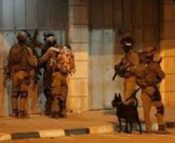
The Palestinian Prisoners Society (PPS) has reported that Israeli soldiers have abducted, overnight and earlier Monday, at least ten Palestinians, including a child, in different parts of the occupied West Bank, and injured five Palestinians near Jericho, including one who suffered serious wounds.
The Hebron office of the PPS, in the southern part of the West Bank, said the soldiers invaded and searched many homes in the Hebron district, including the city itself, and abducted seven Palestinians.
It identified the abducted as Ahmad Eghneimat, 52, Osama Mustafa Makhamra, Shadi Zein, Mohammad Mahmoud Awad, 31, Nadim Ibrahim Sabarna, 35, Mohammad Nasser Rajabi and Ahmad Ateyya al-Metwer.
In Bethlehem, the soldiers abducted a child, identified as Mohammad Ibrahim Abu Yabes, 15, and summoned two others from Doha town, west of Bethlehem, for interrogation.
The soldiers also invaded Salfit district, searched homes and abducted Ismael Aziz Mer’ey, 27.
In Tulkarem, in the northern part of the West Bank, the soldiers abducted a man, identified as Hussein Nawwaf Jallad, 40.
In Nablus, also in the northern part of the occupied West Bank, media sources have reported that clashes took place between dozens of soldiers and local youths, after the army invaded the city, and stormed dorms for female students.
Furthermore, the soldiers invaded al-‘Oja village, northeast of Jericho, and clashes with local youths, who hurled stones and empty bottles at the military jeeps, while the soldiers fired live rounds, gas bombs and rubber-coated steel bullets.
Medical sources said five Palestinians were injured, including one who suffered serious wounds before he was moved to a local hospital.
The Hebron office of the PPS, in the southern part of the West Bank, said the soldiers invaded and searched many homes in the Hebron district, including the city itself, and abducted seven Palestinians.
It identified the abducted as Ahmad Eghneimat, 52, Osama Mustafa Makhamra, Shadi Zein, Mohammad Mahmoud Awad, 31, Nadim Ibrahim Sabarna, 35, Mohammad Nasser Rajabi and Ahmad Ateyya al-Metwer.
In Bethlehem, the soldiers abducted a child, identified as Mohammad Ibrahim Abu Yabes, 15, and summoned two others from Doha town, west of Bethlehem, for interrogation.
The soldiers also invaded Salfit district, searched homes and abducted Ismael Aziz Mer’ey, 27.
In Tulkarem, in the northern part of the West Bank, the soldiers abducted a man, identified as Hussein Nawwaf Jallad, 40.
In Nablus, also in the northern part of the occupied West Bank, media sources have reported that clashes took place between dozens of soldiers and local youths, after the army invaded the city, and stormed dorms for female students.
Furthermore, the soldiers invaded al-‘Oja village, northeast of Jericho, and clashes with local youths, who hurled stones and empty bottles at the military jeeps, while the soldiers fired live rounds, gas bombs and rubber-coated steel bullets.
Medical sources said five Palestinians were injured, including one who suffered serious wounds before he was moved to a local hospital.
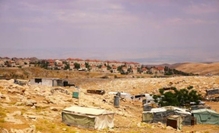
Israeli forces, on Sunday, confiscated an 18-dunam plot of land near Salfit town, in the central occupied West Bank, according to local sources.
Jamal al-Ahmad, a local anti-settlement activist, said that, by declaring the plot a state land, Israel will have taken over 138 dunams of land in the area, for the benefit of expanding the industrial zone of nearby Ariel settlement.
He noted, according to WAFA, that Israel has allocated this land to Israeli investors to open their own business there, under the pretext of it being a state property.
In related news, Israeli forces ordered 10 families in the Khirbet Ibzeiq area of the occupied West Bank district of Tubas, in the Jordan Valley, to evacuate their homes to make way for Israeli military drills in the area.
Aref Daraghmah, who monitors Israeli violations in Tubas, said that Israeli forces informed the 10 families, mostly from the Turkman clan, that they needed to leave their homes on Sunday, in order for the Israeli military to carry out drills there.
Daraghmeh added that, in accordance with recent military orders, other families in the Ras al-Ahmar area, nearby, are also due to leave their homes on Sunday and Monday for similar military drills.
Palestinian residents of the Jordan Valley face regular evacuations for Israeli military exercises on or near their land. The district of Tubas is one of the occupied West Bank’s most important agricultural centers.
On an almost weekly basis, the Israeli army orders Palestinian Bedouins residing in the Jordan Valley to leave their homes, to make way for live-fire trainings.
Many Palestinians in the Jordan Valley see military exercises in firing zones, as well as repeated house demolitions as an Israeli strategy to empty the land of Palestinians and confiscate it for further settlement expansion and agricultural production.
In May of 2014, a senior Israeli army officer reported that military training in live-fire zones, in the occupied West Bank , is used “as a way of reducing the number of Palestinians living nearby, and serves as an important part of the campaign against Palestinian illegal construction.”
Colonel Einav Shalev also described the Israeli army policy of confiscating humanitarian equipment, destined for Palestinians whose homes have been destroyed, as ‘a punch in the right places’.
Jamal al-Ahmad, a local anti-settlement activist, said that, by declaring the plot a state land, Israel will have taken over 138 dunams of land in the area, for the benefit of expanding the industrial zone of nearby Ariel settlement.
He noted, according to WAFA, that Israel has allocated this land to Israeli investors to open their own business there, under the pretext of it being a state property.
In related news, Israeli forces ordered 10 families in the Khirbet Ibzeiq area of the occupied West Bank district of Tubas, in the Jordan Valley, to evacuate their homes to make way for Israeli military drills in the area.
Aref Daraghmah, who monitors Israeli violations in Tubas, said that Israeli forces informed the 10 families, mostly from the Turkman clan, that they needed to leave their homes on Sunday, in order for the Israeli military to carry out drills there.
Daraghmeh added that, in accordance with recent military orders, other families in the Ras al-Ahmar area, nearby, are also due to leave their homes on Sunday and Monday for similar military drills.
Palestinian residents of the Jordan Valley face regular evacuations for Israeli military exercises on or near their land. The district of Tubas is one of the occupied West Bank’s most important agricultural centers.
On an almost weekly basis, the Israeli army orders Palestinian Bedouins residing in the Jordan Valley to leave their homes, to make way for live-fire trainings.
Many Palestinians in the Jordan Valley see military exercises in firing zones, as well as repeated house demolitions as an Israeli strategy to empty the land of Palestinians and confiscate it for further settlement expansion and agricultural production.
In May of 2014, a senior Israeli army officer reported that military training in live-fire zones, in the occupied West Bank , is used “as a way of reducing the number of Palestinians living nearby, and serves as an important part of the campaign against Palestinian illegal construction.”
Colonel Einav Shalev also described the Israeli army policy of confiscating humanitarian equipment, destined for Palestinians whose homes have been destroyed, as ‘a punch in the right places’.
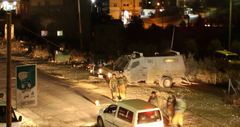
The Israeli occupation forces arrested two teenagers from Sa’ir town in al-Khalil following violent clashes on Sunday evening with young men in a nearby area.
Local sources told the Palestinian Information Center (PIC) that the skirmishes between local young men and Israeli soldiers started after the latter set up a makeshift checkpoint at the entrance to Sa’ir town and embarked on searching passing vehicles and passengers.
They added that the young men hurled stones at the soldiers, who responded by intensively firing tear gas grenades.
Afterwards, a group of soldiers chased the young men into al-Dawara neighborhood of the town and captured two teenagers.
Local sources told the Palestinian Information Center (PIC) that the skirmishes between local young men and Israeli soldiers started after the latter set up a makeshift checkpoint at the entrance to Sa’ir town and embarked on searching passing vehicles and passengers.
They added that the young men hurled stones at the soldiers, who responded by intensively firing tear gas grenades.
Afterwards, a group of soldiers chased the young men into al-Dawara neighborhood of the town and captured two teenagers.
13 nov 2016
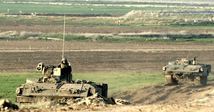
Israeli armored heavy vehicles on Sunday morning infiltrated limitedly into a border agricultural area in Beit Lahia, north of the Gaza Strip, under military protection.
Local sources told the Palestinian Information Center (PIC) that four army bulldozers came from the military outpost of Zakim and advanced into an agricultural area on the northern border of Gaza.
The sources added that the bulldozers embarked on flattening raised areas before they moved towards the northern border of Beit Hanoun.
Local sources told the Palestinian Information Center (PIC) that four army bulldozers came from the military outpost of Zakim and advanced into an agricultural area on the northern border of Gaza.
The sources added that the bulldozers embarked on flattening raised areas before they moved towards the northern border of Beit Hanoun.
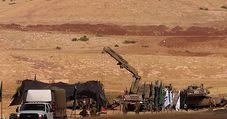
The Israeli occupation army is expected to carry out large-scale military drills from Sunday to Thursday across the occupied Palestinian territories.
The Israeli 0404 news site quoted the occupation army’s spokesman as claiming that the maneuvers make part of an Israeli military plan for 2016 aiming to uphold the competence and promptness of the occupation forces in an anticipation of any emergencies.
The ground, air, and navy forces are expected to take part in the five-day drills.
Sounds of red sirens and random gunfire shots are expected be detected all the way through the drills.
Earlier on Saturday, the Israeli Channel 7 said the maneuvers are expected to kick off on Sunday in 1948 Occupied Palestine.
It added that heavily-armed military jeeps and vehicles are expected to scour the area while fighter aircrafts will be hovering over the territory without prior notifications.
Palestinian civilians raised concerns that such military drills would intensify their children’s traumatized psyches after images of warfare and bloodshed have turned into a fact of life in the occupied Palestinian territories.
The Israeli 0404 news site quoted the occupation army’s spokesman as claiming that the maneuvers make part of an Israeli military plan for 2016 aiming to uphold the competence and promptness of the occupation forces in an anticipation of any emergencies.
The ground, air, and navy forces are expected to take part in the five-day drills.
Sounds of red sirens and random gunfire shots are expected be detected all the way through the drills.
Earlier on Saturday, the Israeli Channel 7 said the maneuvers are expected to kick off on Sunday in 1948 Occupied Palestine.
It added that heavily-armed military jeeps and vehicles are expected to scour the area while fighter aircrafts will be hovering over the territory without prior notifications.
Palestinian civilians raised concerns that such military drills would intensify their children’s traumatized psyches after images of warfare and bloodshed have turned into a fact of life in the occupied Palestinian territories.
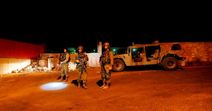
The Israeli occupation forces (IOF) on Saturday evening sealed off the main entrance to al-Khalil’s towns of Sa’ir and al-Sheyoukh with a military checkpoint.
A PIC news correspondent said the IOF pitched a military checkpoint on the accessroad to Sa’ir and al-Sheyoukh towns, where Palestinian vehicles and civilians were subjected to intensive inspection.
Meanwhile, over 40 Israeli soldiers stormed Namra neighborhood, in eastern al-Khalil, and raked through the area, sparking panic among children and women.
The Palestinian anti-occupation protesters responded to the assault by hurling stones on the occupation troops as they passed through Bypass Road 60 to the east of the Israeli illegal settlement of Kiryat Arba.
A PIC news correspondent said the IOF pitched a military checkpoint on the accessroad to Sa’ir and al-Sheyoukh towns, where Palestinian vehicles and civilians were subjected to intensive inspection.
Meanwhile, over 40 Israeli soldiers stormed Namra neighborhood, in eastern al-Khalil, and raked through the area, sparking panic among children and women.
The Palestinian anti-occupation protesters responded to the assault by hurling stones on the occupation troops as they passed through Bypass Road 60 to the east of the Israeli illegal settlement of Kiryat Arba.
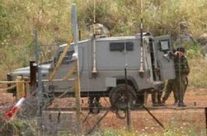
Israeli soldiers opened fire, on Saturday evening, at several Palestinian homes, and agricultural lands, east of Khan Younis, in the southern part of the coastal region.
Media sources said the attack causing damage, while several Palestinians, especially children, suffered anxiety attacks.
The sources added that the soldiers fired many live rounds at the homes, and nearby lands, especially close to the border fence, in southern Gaza.
The Israeli army conducts frequent attacks against the Palestinians, their homes and property, in areas that are close to the border fence, in addition to ongoing attacks, by the navy against the fishers and their boats, in Gaza territorial waters.
Media sources said the attack causing damage, while several Palestinians, especially children, suffered anxiety attacks.
The sources added that the soldiers fired many live rounds at the homes, and nearby lands, especially close to the border fence, in southern Gaza.
The Israeli army conducts frequent attacks against the Palestinians, their homes and property, in areas that are close to the border fence, in addition to ongoing attacks, by the navy against the fishers and their boats, in Gaza territorial waters.
12 nov 2016
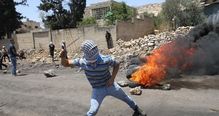
Many Palestinian citizens suffered injuries during clashes on Friday afternoon with Israeli soldiers at the entrance to Taqua town in Bethlehem, while an Israeli military force kidnapped two children in Dura town in al-Khalil.
Local sources reported that two young men suffered rubber bullet injuries in the lower parts of their bodies and many others suffered from inhaling tear gas during clashes with soldiers in al-Sha’er street at the entrance to Taqua town, east of Bethlehem.
Similar clashes broke out between young men and soldiers in Aida refugee camp, north of Bethlehem. Some youths had tear gas injuries during the skirmishes.
In al-Khalil, the Israeli army closed on the same day the main entrances to Dura town and al-Fawwar refugee camp, which provoked angry protests from local young men.
Local sources said that skirmishes happened between young men and soldiers at the southern entrance to Dura town after two vital roads leading to Dura and Fawwar camp were closed by the Israeli occupation forces.
They added that the Israeli army ordered the closure of these two roads after settlers’ cars were reportedly attacked with stones on Road 60.
Meanwhile, two Palestinian kids were kidnapped by Israeli soldiers from Wadi Abul-Qamra area in Dura town, according to eyewitnesses.
The identities of the boys are still unknown
The soldiers also detained another boy aged 8 for some hours in the same area of Dura before letting him go.
In another incident, the presence of an Israeli military force in Beit Einun town, north of al-Khalil, triggered clashes with local young people on Friday evening.
Local sources said that soldiers set up a makeshift checkpoint at Beit Einun junction and embarked on searching passing vehicles, which angered local youths and prompted them to hurl stones and glass bottles at the latter.
Soldiers, in turn, launched gunfire and tear gas attacks against the protestors. The skirmishes continued for a while until the military force withdrew from the town later on the same day.
Local sources reported that two young men suffered rubber bullet injuries in the lower parts of their bodies and many others suffered from inhaling tear gas during clashes with soldiers in al-Sha’er street at the entrance to Taqua town, east of Bethlehem.
Similar clashes broke out between young men and soldiers in Aida refugee camp, north of Bethlehem. Some youths had tear gas injuries during the skirmishes.
In al-Khalil, the Israeli army closed on the same day the main entrances to Dura town and al-Fawwar refugee camp, which provoked angry protests from local young men.
Local sources said that skirmishes happened between young men and soldiers at the southern entrance to Dura town after two vital roads leading to Dura and Fawwar camp were closed by the Israeli occupation forces.
They added that the Israeli army ordered the closure of these two roads after settlers’ cars were reportedly attacked with stones on Road 60.
Meanwhile, two Palestinian kids were kidnapped by Israeli soldiers from Wadi Abul-Qamra area in Dura town, according to eyewitnesses.
The identities of the boys are still unknown
The soldiers also detained another boy aged 8 for some hours in the same area of Dura before letting him go.
In another incident, the presence of an Israeli military force in Beit Einun town, north of al-Khalil, triggered clashes with local young people on Friday evening.
Local sources said that soldiers set up a makeshift checkpoint at Beit Einun junction and embarked on searching passing vehicles, which angered local youths and prompted them to hurl stones and glass bottles at the latter.
Soldiers, in turn, launched gunfire and tear gas attacks against the protestors. The skirmishes continued for a while until the military force withdrew from the town later on the same day.
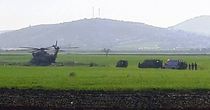
The Israeli occupation army on Friday night ordered the Bedouin residents of a-Ras al-Ahmar hamlet, east of Tammun town in Nablus, to evacuate their homes in order for its forces to conduct military drills in the coming days.
A resident told the Palestinian Information Center (PIC) that nine families, including children, would be homeless as a result of these drills that would take place for two days as of Sunday, 13 November.
He complained that these military exercises would also destroy their cultivated fields and grazing land and would increase the financial burdens on the residents as a result of their displacement from their area.
He noted that the Israeli army had conducted similar drills one week ago and forced them to leave their homes.
Ras al-Ahmar is one of the most prominent Bedouin hamlets whose residents greatly suffer from Israel’s military drills and activities.
A resident told the Palestinian Information Center (PIC) that nine families, including children, would be homeless as a result of these drills that would take place for two days as of Sunday, 13 November.
He complained that these military exercises would also destroy their cultivated fields and grazing land and would increase the financial burdens on the residents as a result of their displacement from their area.
He noted that the Israeli army had conducted similar drills one week ago and forced them to leave their homes.
Ras al-Ahmar is one of the most prominent Bedouin hamlets whose residents greatly suffer from Israel’s military drills and activities.

The Israeli army’s Bedouin tracker unit started Friday large-scale drills along the border of Gaza aimed at training to detect and deal with tunnels and cross-border infiltration incidents during war-like conditions.
According to the army radio, these large-scale military drills will last for two weeks along the border with Gaza and simulate the occurrence of underground incursions and fence breaches during a war.
Rabie Sawa’id is the chief tracker who commands a small unit of Negev Bedouin soldiers who use their field craft skills to serve as the Jewish state’s gatekeepers along the Gaza borderline.
He told the radio that almost no operational activity is carried out by the Israeli army on Gaza border without soldiers from his unit being ahead of other patrol troops.
The Israeli army has recently stepped up attempts to recruit soldiers from impoverished Bedouin communities in order to use them as scouts, especially during military advances to protect Israeli troops.
According to the army radio, these large-scale military drills will last for two weeks along the border with Gaza and simulate the occurrence of underground incursions and fence breaches during a war.
Rabie Sawa’id is the chief tracker who commands a small unit of Negev Bedouin soldiers who use their field craft skills to serve as the Jewish state’s gatekeepers along the Gaza borderline.
He told the radio that almost no operational activity is carried out by the Israeli army on Gaza border without soldiers from his unit being ahead of other patrol troops.
The Israeli army has recently stepped up attempts to recruit soldiers from impoverished Bedouin communities in order to use them as scouts, especially during military advances to protect Israeli troops.
